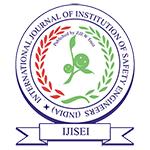Effective Method of Behavior Based Risk Evaluation and Control Measure in any Organization
Volume 3, Issue 2, April – June 20
Effective Method of Behavior Based Risk Evaluation and Control Measure in any Organization
Shahnawaz Rampuri
Email id: shahnawaz.rampuri2@gmail.com
Abstract
Behavior based safety is systematic and effective approach that create self-desire among employees to adopt best safety practices and procedures to control work place risk. In behavior based safety employee use safe behavior during performing any work, means employee change their behavior from risk behavior to safe behavior. In this approach, employees prevent to human error during performing their job in industries to bring safety in their behavior. This study is carried out to identify best approach and techniques to evaluate behavior of employees and how can change the behavior of employees from negative (Risk) behavior to Positive (safe) behavior. In this paper, we will discuss connection of employee attitude with their behavior. Therefore, this paper is very helpful to know the best method to evaluate negative behavior, risk related to such behavior and use effective method to change unsafe behavior into safe behavior of employees.
Key word: Behavior Based Safety (BBS), Method to develop positive behavior based safety among employees, ISEI Method, BEAPI Method, Impact of behavior based safety to organization, Behaviour based risk evaluation & Risk management method.
Objective
- Creating awareness among organization employees.
- Developing Positive Behavior among people to prevent human error.
- Changing Risk Behavior to Safe Behavior of employees.
- Control to organizational Harm to Prevent risk behavior.
- Fulfilling statutory compliance and achieving world class industries reputation in market.
1. Introduction:
Behaviour Based Safety (BBS) is an approach and effective method, used to change risk behavior of employee to safe behaviour. Risk behaviour always leads to cause of organizational harm in term of injury, death, property damage, environmental damage or combination of these. BBS plays vital role to create safe work place to eliminate such behavioral risk of human that may lead to cause of unsafe acts and unsafe conditions. Now majority of industries such as construction industries, process industries, Tour, Travels and other sector industries are focusing to behavior based safety (BBS) because they know future impacts to organisation of negative behavior. Negative Behaviour creates human error and its results accident. Accident causes of huge losses to organizational harm. Main causes of accident in industries are due to negative behavior of employees and there may be several factors responsible to develop negative behavior among employees and create unsafe work environment (Fig. 5).
Behaviour based safety is totally depend on attitude of employees or people. In Simple ways consequence of Attitude is known as behavior and Consequence of positive attitude is known as Positive behavior of employees. Positive behavior of employee always helps to prevent accident and it results to organization success (Fig. 1).

Fig. 1, Probability of organization success on based employees Behavior
2. Behavior Based Safety V/s Attitude
2.1 Behavior Based Safety
Consequence of Attitude is known as human Behavior and it may be positive or negative behavior. Behavior based safety of employees can be defined from many ways and few ways to define behavior-based safety are:
- Behavior Based Safety (BBS) is result of employees or people Positive attitude.
- Method or technique of injury or disease or organizational harm prevention.
- Focus on safe behavior and acting accordingly.
- Prevent to Risk behavior from organisation.
- Chain between management representative and employees and work together to adopt safety rules and procedures to minimize or control risk related to negative behaviour.
- Approach that help to create self-desired among employee to Prevent Risk/ Unsafe behavior.

Fig. 2, Behavior Based Safety of employees
2.2 Attitude
Attitude of employees is major parameter of behavior. Behavior is results of employee attitude. Attitude can be defined as following ways:
- The ways you FEEL
- They ways you ACT
- The ways to COMMUNICATE to People
- The ways you THINK
In simple word, Attitude can be defined as the result that shows to others of your feeling, thinking, talking and acting. To understand Attitude FACT is best term to define, F means feel, A means Act, C means communicate and T means think or talk.
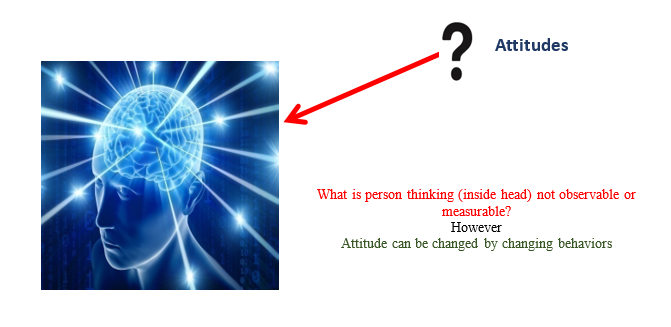
Fig. 3, Attitude can be change through Behaviour
Attitude is directly relates to behavior of employee. If employees attitude will be positive then behaviour will be positive and if their Attitude will be negative, then behavior will be negative. Attitude can be categorize into Safe Attitude that is known as positive attitude, unsafe attitude that is known as negative attitude and neutral attitude that means employee believe in safe behavior as well as unsafe behavior (Table 1).
| Negative Behaviour | Neutral Behaviour | Positive Behaviour |
| Employees not follow Safety rules & procedures | Some time employee believes in safety rules, procedures and follow it or sometimes not. | Employees follow Safety rules & procedures |
Table 1, Employees behaviour
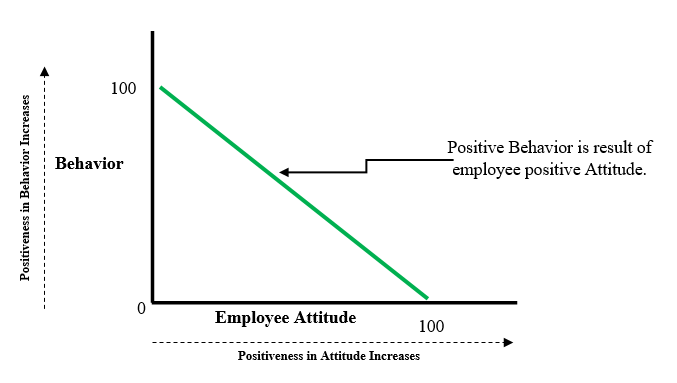
Fig. 4 Employees attitude versus behavior graph
Employee behaviour is directly proportional to Attitude. If employees attitude are positive then it will develop positive behavior among employees and result to prevent such human error or situation that lead to cause of accident or any organizational harm.
3. Results of Attitude and cause to develop Negative attitude among employees
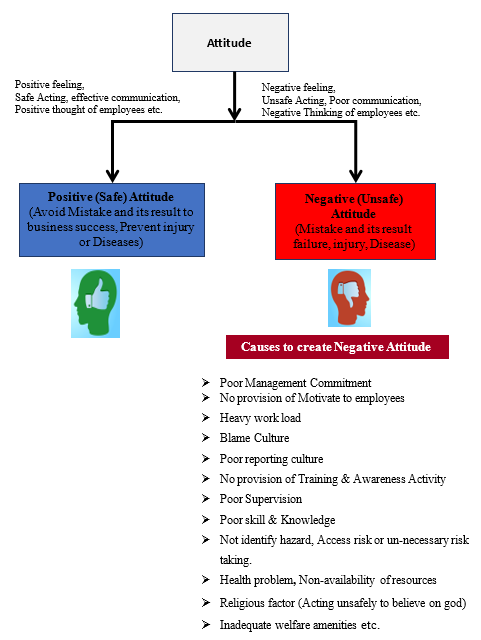
Fig. 5, Results of Attitude and cause to develop Negative attitude among employees
4. Comparison between Safe Attitudes & Unsafe Attitude

5. Understanding Behavior
To understanding behavior of employees, it is important to understand their attitude. Behavior of employees depends on their Attitude. If attitude will be positive, it means employees will follow safety rules and procedure to avoid any type of human error and creating safe healthy work environment. If Employees attitude will be negative, means they shall not follow safety rules, procedures and belief in un-necessary risk taking and it results injury, Accident or any organizational harm.
To identify and evaluate risk related to attitude of employees is very tough because without seeing employee acts, No any person can identify the nature of behavior and without identifying behavior of employee, risk can’t be evaluated. Therefore behavior can be identified to see the acts of employee and attitude can be change by change of behavior. There are many factors responsible for people behavior (Fig.7).
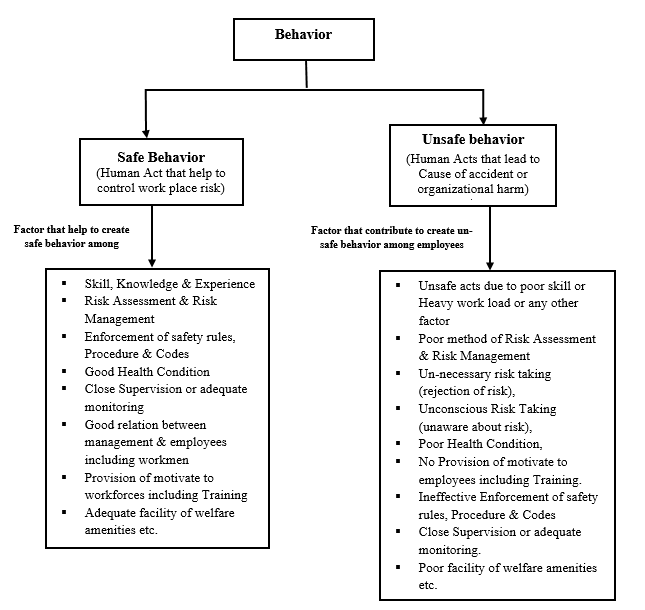
Fig. 7, Understanding employees Behavior
6. Results & Discussion:
A study carried out by Institution of Safety Engineers (India) on Five thousand Thirteen employees including workers of Manufacturing, Construction, Hotel and hospitality sector industries during Jan.- Septembe 2019 in India and found that presence of risk behavior employees including workmen in construction industries is more than manufacturing and Hotel/Hospitality industries (Fig.8). In this Study, human behaviour is categorised in three parts, Negative, Neutral and positive behavior of people. Neutral behavior means employees have Positive attitude as well as negative attitude respect to safety (Table 1). As per study, small or medium scale construction industries, risk behavior employees are more than large construction industries. In this study, main factors are identified, industries wise that are responsible to develop risk (Negative) behavior within organisation.
In Construction Industries, Approx. 60 percent employees were positive behaviour, 13 percent employees were negative behaviour & 27 percent employees were neutral behaviour. In manufacturing industries, 79 percent employees were Positive Behaviour employees, 5 Percent employees were negative behaviour & 16 Percent employees were neutral behaviour. In Hotel & Hospital sector industries, 69 percentage employees were Positive behaviour, 11 Percent employees were negative behaviour & 20 Percent employees were neutral behaviour (Fig. 8). Factors also identified that was responsible to develop risk behavior in Construction Industries, Manufacturing Industries and Hotel/ Hospitality Industries (Fig.9).

Fig. 8, Behavior of Employees including workers industries wise, Sources ISEI

Fig. 9, Responsible Factor to develop Risk Behavior in industries, Sources ISEI
7. Behavior based risk evaluation method and Risk Management Method
Behavior related risk can be evaluated to identify attitude of employee. Attitude is outcome of acts of employee that is known as behaviour. Firstly, we identify to employee attitude to see their acts and then identify to human error, whenever human error observed then we see the likelihood (Probability) of hazardous event occurring and if there is any probability of hazardous event occurring then what will be their consequence and on based on this, risk is to be evaluated. If there is no probability of event occurring, means employees have positive attitude and positive behavior. If attitude creates such condition that results accident or any organizational harm, means employees have negative attitude. In case of negative behaviour, Need to evaluate behavioural risk and take needful action to minimize or reduce such risk upto tolerable level.
To control workplace behavioural risk, Need to eliminate/ reduce Likelihood of hazardous event occurring or eliminate/reduce to severity of harm. Behavioural related risk can be also control through to eliminate/reduce likelihood of event and severity of harm both together to take adequate control measure.
Behavioural Risk: Probability of Hazardous event occurring due to negative (Risk) behavior X
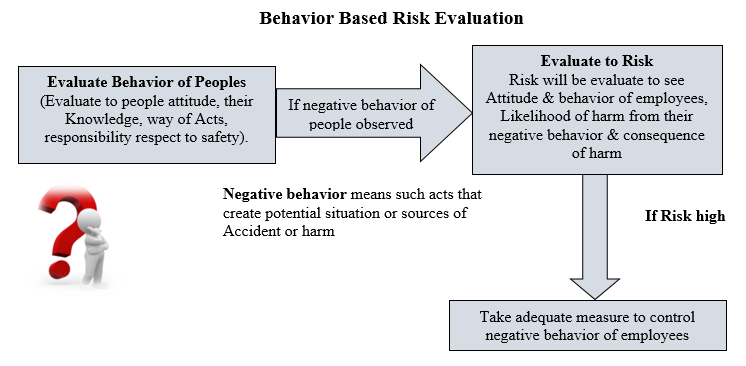
Fig. 10, Sources, IJISEI Vol. 2, Issue 2, Page 4, Mr. Aloke Pathak, Need of BBS in Industries
7.1 Identification of Employees Behaviour respect to Safety though ISEI Method.
ISEI is very effective method used to identify behavior of employees. In this method four term I, S, E & I used, so it is called ISEI behavior based safety evaluation method. This method is as summarized below.
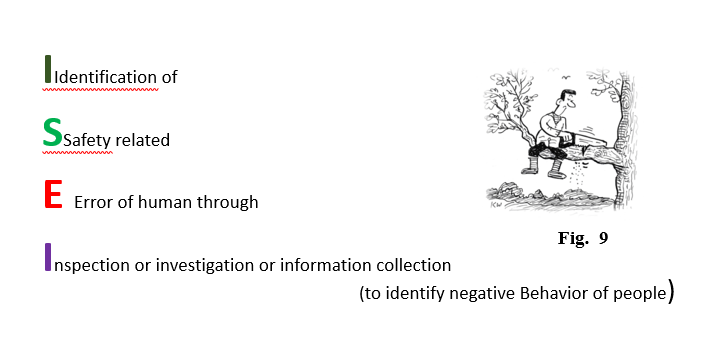
ISEI method is defined as identification of Safety related Error of employee (human) through inspection/ Investigation or information collection (employee background such as their knowledge, qualification, experience, health condition etc.) method from different sources to find cause of negative behavior. This method is develop by Institution of Safety Engineers (India)
7.2 BEAPI method
BEAPI is effective method of behavior based risk evaluation and ensuring effective control measure to control behavioural related risk. Institution of Safety Engineers (India) identified to this method. BEAPI is defined as behavior evaluation of employees, action plan must be prepare and ensure it’s strictly implementation. In this method, we identify different elements related to behaviour of employees and based on this each element is categories in sub-elements and check to compliance of each sub-elements. BEAPI is summarised as
BE: Behaviour Evaluation
Select the element as per nature of organization and identify sub-element of each element and check their compliance status. Few Elements related to behavior of people are:
- Work method & position (Behavioral)
- PPE uses (Behavioral)
- Safety Rules, Regulation Compliance (Behavioural)
- Tools & equipments (Behavioural)
- Housekeeping Compliance (Behavioural)
- Participation in Safety Program such as Training, meeting etc. (Behavioural)
- Hygiene & Welfare Amenity and their Proper utilization (Behavioural)
Categories to element of BBS into sub element and check their compliance and take needful action whenever require:
Not Applicable
Complied
Under Progress
Not-Complied
AP: Action Plan Preparation
Prepare Action plan, as on observed negative behavior of employees. Plan should be realistic and effective. To prepare plan discuss with management about plan for effective implementation. In Action plan many parameter such as training, health monitoring, supervision, compliance of welfare amenities, Safety laws and procedure like is considered.
I: Implement to action plan
Implement to action plan effectively, check and review compliance status as per action plan or recommendation as per observation time to time.
In this method basically Three parts (phase), First phase is Behavioural based risk evaluation, second Phase is prepare action Plan and Third phase is to implement to action plan. Time to time it should be review and corrective/preventive measure should be taken to control behavioural related risk.
In Short Form BEAPI method are written as
B: Behavior- Identify to Employees behavior (If behavior will be negative then there will be Risk of Harm)
E: Evaluation- Evaluate risk associated with Negative behavior
A: Action Plan – Prepare or Develop Action Plan
P: Preparation – Prepare or Develop Action Plan
I: Implementation– Implement to action plan effectively
Time to time need to check compliance status and take needful action for improvement in organization Safety system to develop positive behaviour among employees.
Fig. 10, ABC Model

7.3 ABC Model
ABC model is best tool to change human behavior. Most of today’s behavioral safety effort are based on this theory that says all behaviors are a result of antecedents and consequences (Fig. 10).
7.4 Behavior based risk evaluation &Management Method
Risk is calculated to see the likelihood of hazardous event and consequence (Severity of harm) of hazardous event occurring due to negative behavior of employee. Behavioural based Risk is exposure of potential source of harm and their impacts (severity of harm) due to negative behaviour. Behavioural related risk can be control to take adequate safety control measure (Fig. 11)
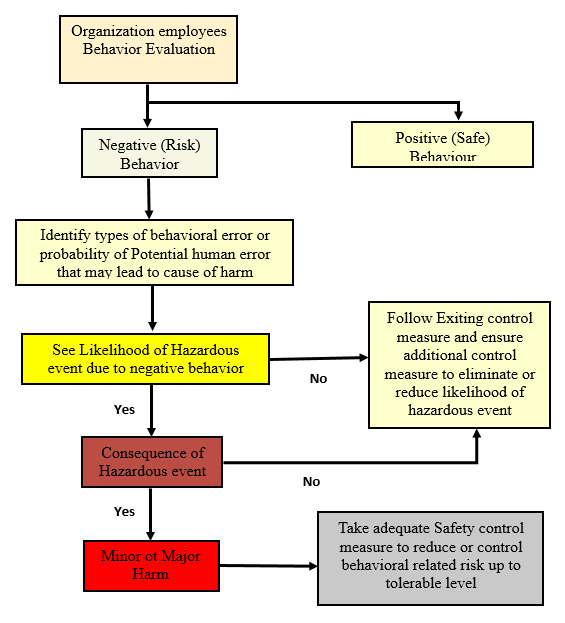
Fig. 11, Behavior based risk evaluation &Management Method
Conclusion
Behaviour based safety (BBS) is a positive approach that create self-desire among employees to perform their job safely. Employees perform their job safely to follow safety procedures, rules & regulation and they belief in safety with intention to complete their job without any harm. Behaviour based safety is associated with attitude of employees. Negative attitudes of employees always creates obstacle in implementing effective Safety management system in industries and attitude of employees can be change to change the behavior of employees. Several methods such as ISEI, BEAPI are very helpful to identify behavior based safety related risk and taking adequate control measure to minimize employee behavioural risk upto tolerable level. There may be several cause of negative attitude of employees such as ineffective enforcement of safety rules, Poor skill, health problem, heavy workload, poor or no provision of motivate to workforce, poor reporting culture, poor supervision etc. Management should identify applicable element and sub-element of bheaviour based safety and based on this need to ensure compliance effectively. Health monitoring & Counseling of employees also help to identify employee behaviour. Safety activity such as training, Reward program help to develop behavior based safety among employees. Main objective of behavior based safety is change the behavior of employees from risk behavior to safe behavior.
References:
- ISEI Manuals
- Safety Culture in Organization: A Review, Shamim Rayani, International Journal of Institution of Safety Engineers (India), Volume 3, Issue 1, Jan-March.20, Page 30-39
- Need of Behaviour Based Safety in Industries, Mr. Alok Pathak, International Journal of Institution of Safety Engineers (India), Volume 2, Issue 2, Apr-June 19, Page 01-05
- IS 18001 & IJISEI Journal
